Minang, Goreng, Wudjari, Njunga Country
It is early 2021 and Australia in common with the global community, was in the middle of the coronavirus pandemic, with the West Australian state border closed to the outside world. Disappointed like many with cancelled travel plans, I elected to use the pandemic period constructively.
On bush trips I continually encounter those most Australian of plants the Banksias. Banksias are a plant genus almost entirely endemic to Australia.
There are 79 species (and counting,) of which an impressive 61 species are found in Southwestern Australia. The various species flower year round with the nectar, and insects attracted to that nectar, an important source of nutrition for native wildlife.
There is an excellent Book titled Banksias (second edition) written by Kevin Collins, Kathy Collins and Alex George that acts as a fantastic guide for Banksia enthusiasts.
What began as a small local project to view some local Banksias, ultimately grew to span almost four years and the length and breadth of the Southwest.
In this the third part of the four part series, the spectacular species of Western Australia’s wild South Coast are the focus.
Continued from :- Banksias of the true Southwest – The Cool, Damp Corner.
Fitzgerald River National Park (East.)
Fitzgerald River National Park is a jewel amongst Western Australia’s spectacular National Parks. It stretches from Bremer Bay in the West to Hopetoun in the East, and contains the standout granite peaks of East, Mid and West Mount Barren.
The park contains more mammal species than any other National Park in WA listing an impressive 22 mammals, around 200 bird species and nearly 1800 species of plant (around 20% of all species in WA.) It is especially rich in Banksia species containing by my estimate 17 species, over a quarter of all Western Australia’s Banksias.
East Mount Barren.

Banksia oreophila – The Western Mountain Banksia
An inhabitant of the quartzite slopes of East Mount Barren is Banksia oreophila, literally translated as mountain-lover, it is the high altitide Banksia of Western Australia, being found at both this location and the magnificent lofty Stirling Ranges further West.
Good stands can be seen on the walk trail to the top of East Mount Barren, but fortuntely for the less energetic it is also common at the carpark at The Barrens Lookout on the main drive into the park. A winter flowerer the flowers are a pale pink and very similar to the flowers of Banksia quercifolia found further West.
Banksia oreophila.

Banksia baueri. – The Teddy Bear or Possum Banksia.
The common name of this Banksia is on account of the large orange- cream flowers, the largest flower spike of all the Bankias. The first time a gigantic flower is encountered it literally takes the break away, such is it’s grandeur. It flowers late Autumn into Winter and can be seen at both the Eastern and Western ends of Fitzgerald River National Park.
Banksia baueri.
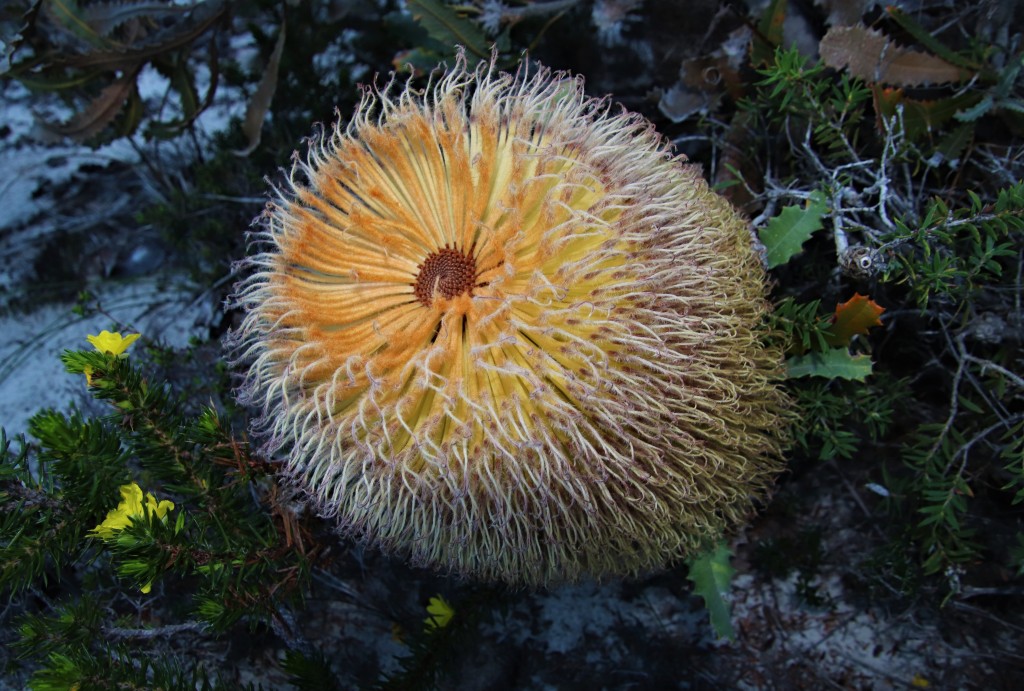
Banksia speciosa – The Showy Banksia.
The “signature” plant of Fitzgerald River National Park is the Lantern Hakea (Hakea victoriae,) but if the Eastern end of the park were to name a signature Banksia, Banksia speciosa would be it.
Hopetoun the service town for the Eastern end of Fitzgerald River National Park, has thickets of this standout Banksia on the sandhills around town.
The range of the species is along the South Coast from East Mount Barren to Israelite Bay, where Banksia speciosa provides food for the prolific local Honey Possum population over Summer. They were encountered in the post below on Banksia speciosa at East Mount Barren carpark.
Fitzgerald River NP – Honey Possums and Banksias.
Banksia speciosa.

Banksia media – The Southern Plains Banksia
A common Banksia of the South Coast from the Stirling Range in the West as far East as Israelite Bay, the yellow flowers of Banksia media can be seen from Autumn into Winter.
In Fitzgerald River National Park the species occurs as a small coastal shrub whilst the same species on Borden-Bremer Bay Rd and at Corackerup and Peniup Nature Reserves is a tree to 10m. The flowering spike can be entirely yellow, or as in the picture tinged with brown/purple perianths.
Banksia media.

Banksia repens – The Creeping Banksia.
One of six ground-creeping Banksias (blechnifolia, chamaephyton, gardneri, goodii, petiolaris, repens.) Due to their proximity to the ground these species use mammals such as the Honey Possum, Bush Rat, Dibbler and Pygmy Possum as pollinators.
They are common along the sandy Moir Track within Fitzgerald River National Park, with the individual below photographed in October during their short flowering period (Oct-Nov.)
Banksia repens.
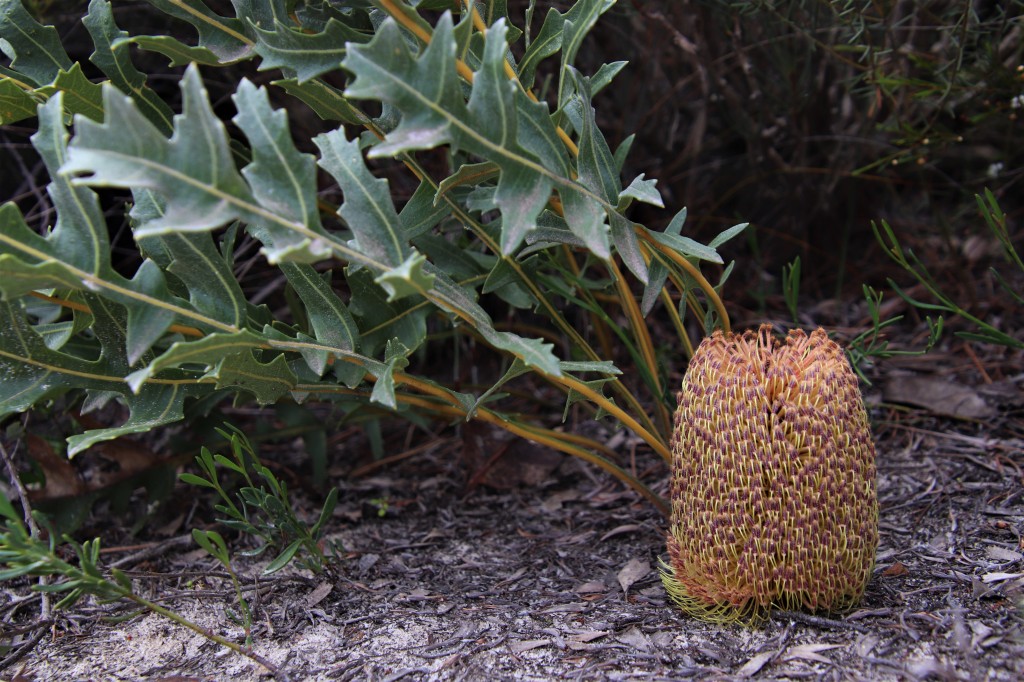
Banksia pulchella – The Teasel Banksia
On the approach to Hopetoun are impressive stands of Banksia speciosa. Closer inspection of the sandy soil within these stands reveals a much smaller Banksia that is similar in appearance to Banksia meisneri. Banksia pulchella reaches a height of only 1m with the main flowering period from Summer through into early Winter, although flowers can be seen at any time of the year.
Banksia pulchella.

Guest Plant
Hakea laurina – The Pin-cushion Hakea
It would be remiss not to include the stunning and entirely fabulous Hakea laurina in this post, when there are such impressive stands of this beautiful plant throughout the Great Southern Region, including on the Hopetoun-Ravensthorpe Rd.
Common along the South Coast from Albany to Esperance and inland through the Wheatbelt this plant is a magnet for nectar-attracted birds when it flowers from April through to July. I have recently planted this species at the Bridgetown property and am excited to see the bird species they will attract on maturity.
Hakea laurina.

Fitzgerald River National Park (West.)
Banksia caleyi – The Red Lantern Banksia
Quiss Road runs from the South Coast Highway down to Pabelup Drive at the Western end of Fitzgerald River National Park. If driving this track during the November then stop and take a look within the obvious large Banksia shrubs bordering the track, for this is the peak flowering of Banksia caleyi.
The scandalous vibrant red of the pendant flowers are not immediately obvious, being hidden within the dense, rigid, prickly foliage, but closer inspection within reveals an abundance of attractive flowers from late Spring into early Summer.
Banksia caleyi.

Banksia nutans – The Nodding Banksia
Another Banksia found on Quiss Road is Banksia nutans, the nodding Banksia. This dainty, diminutive species presents as a small shrub with pendulous flowers close to the ground. The flowers eminate a distinct musty odour similar to an onion.
These two factors along with the drab colouration strongly suggest Banksia nutans is another Banksia pollinated by the prolific small mammals of the kwongan heath. The flower below was seen at the very beginning of the flowering period in early November, the main flowering period being November to February.
The pungent Banksia nutans.

Banksia lehmaniana – Lehmans Banksia
A Banksia impossible to miss in the Fitzgerald River National Park is Banksia lehmaniana. The small tree reaching upto 5m has large attractive brazen yellow flowers. The Banksia below was photographed on Pabelup Drive in the Western Fitzgerald River National Park, but the range extends all the way through the park. It is also common around the town of Ravensthorpe at both Archer Drive Lookout and Ethel Daw Lookout in association here with the Tennis Ball Banksia.
Banksia lehmaniana.
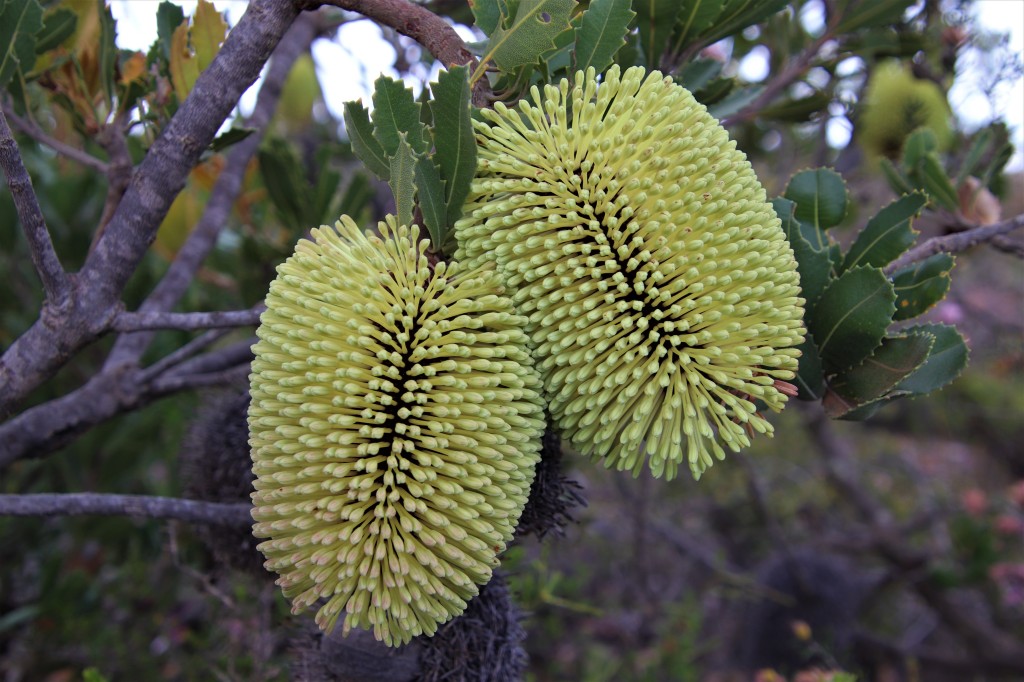
Cheynes Beach
Banksia attenuata – The Candlestick Banksia
Perhaps the most widespread and well known of the West Australian Banksias are the Candlestick Banksias. They are a lover of sand and as such are found along the coast from Kalbarri, where it occurs in a shrubby form with smaller flowers, through Perth, where it forms stands of stately trees over 10 metres in reserves such as Bold Park, and along the South Coast into Fitzgerald River National Park and a considerable distance inland, where it is located in low rainfall reserves such as Tutanning.
This was the species that honed my interest in Banksias when visiting wild Cheynes Beach in 2019 I had a magical encounter with the endemic Honey Possum feeding on a Banksia attenuata. The species flowers from October through Spring and Summer.
The Honey Possum and the Banksia.
Banksia attenuata.
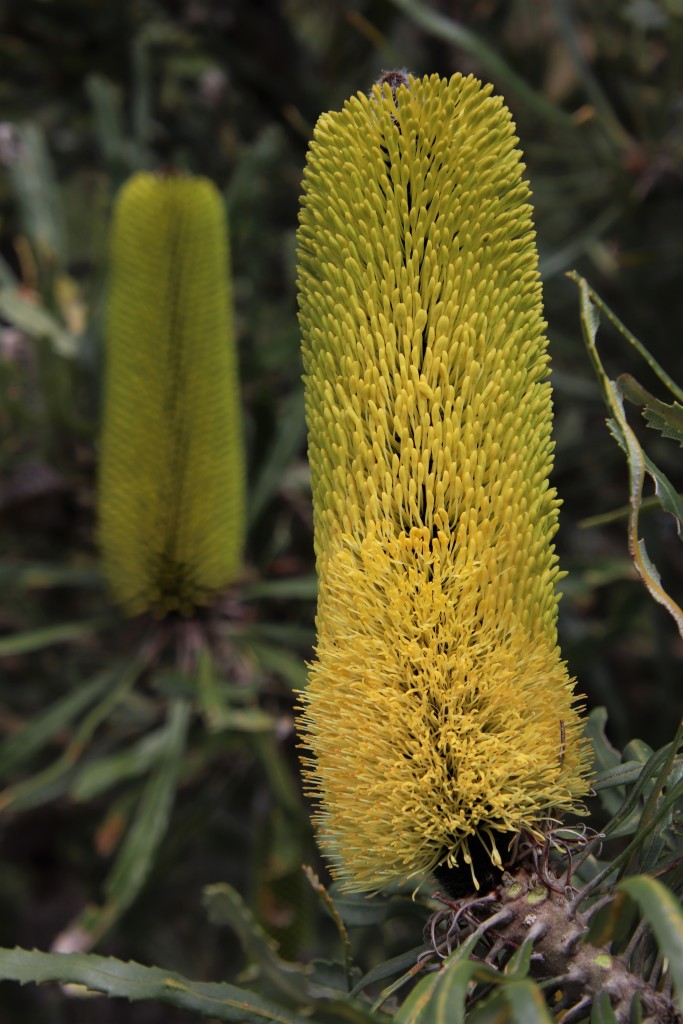
Banksia coccinea – The Scarlet Banksia
Another popular species with the Honey Possum is the distinctive and attractive Banksia coccinea. This predominantly South Coast species also occur in Stirling Range National Park.
A Winter flowerer they provide important nutrition for small mammals and birds this lean time of year. The picture below is taken on the Mermaid Point 4WD Track behind Cheynes Beach, with impressive Mount Manypeaks in the distance.
The flowering cones are so utterley unique, that anyone who comes into contact with this species is captivated. To see a dense stand of a hundred or so of these plants swaying in a brisk South Coast breeze is an unforgettable sight.
Banksia coccinea.
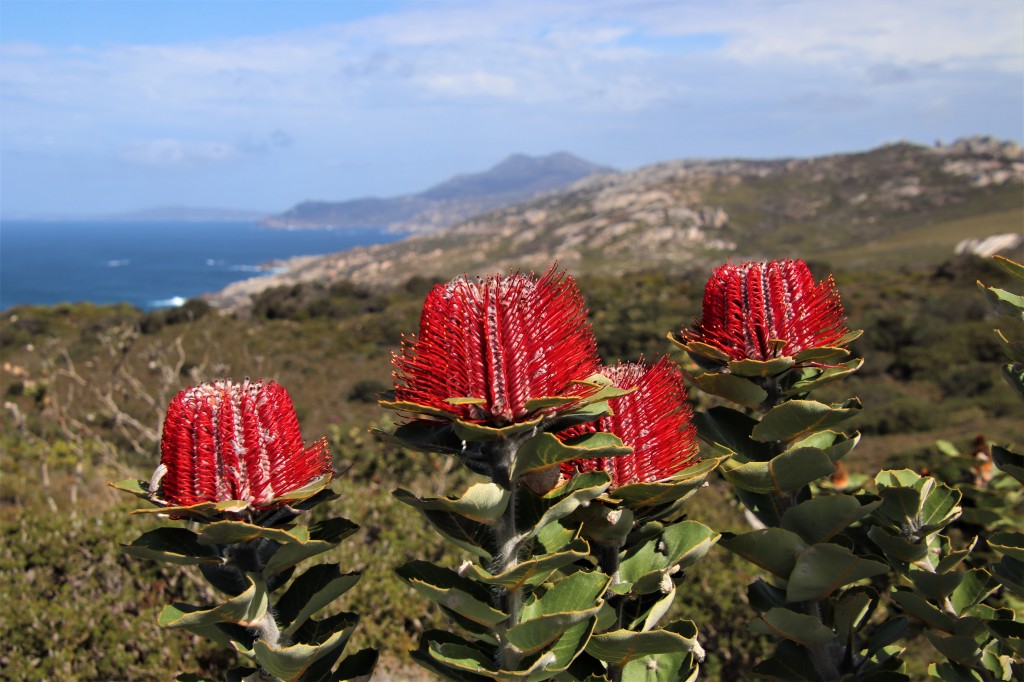
Banksia baxteri – The Bird’s Nest Banksia
Anyone who has visited the South Coast of WA during Summer will have encountered extensive stands of this Banksia. They are a common species at both Cheynes Beach and Fitzgerald River National Park where the flower often provides a perch for a sentinel White-cheeked Honeyeater.
The vernacular name comes from the attractive whorl of leaves surrounding the yellow flowers, with particularly harsh, rigid and spiky-looking leaves.
Banksia baxteri.

Cape Riche
Banksia dryandroides occurs over a relatively small area of the South Coast from South of the Porongorup Range to the Pallinup Estuary occuring over a range of soils including clay, gravel and sand.
Cape Riche falls within this area of distribution, and so on a Spring morning I left the South Coast Highway at Wellstead to follow the unsealed Sandalwood Road through mallee and kwongan heath to the ocean.
Cape Riche is a botanically rich pristine headland jutting out into the Southern Ocean. The morning was cloudy and overcast and suprisingly humid. The search for the Banksia wasn’t immediately sucessful because attaining a height of a mere metre, it is dwarfed by surrounding vegetation. It took the best part of an enjoyable morning exploring the rich dense heathlands before the distinctive foliage revealed the species.
Banksia dryandroides – The Dryandra-like Banksia
Banksia dryandroides presents as a low sprawling bush, which was eventually located amongst a stand of mallee down a rough, sandy 4WD track. The demure ovoid flowering cone, within the dense foliage, was an attractive amber-brown in colour.
The crowded foliage is a twist of long branches lined with rows of tiny triangular leaves. The genesis of the name dryandroides meaning dryandra-like, comes from the similarity of the leaves to that family of plants.
Banksia dryandroides.
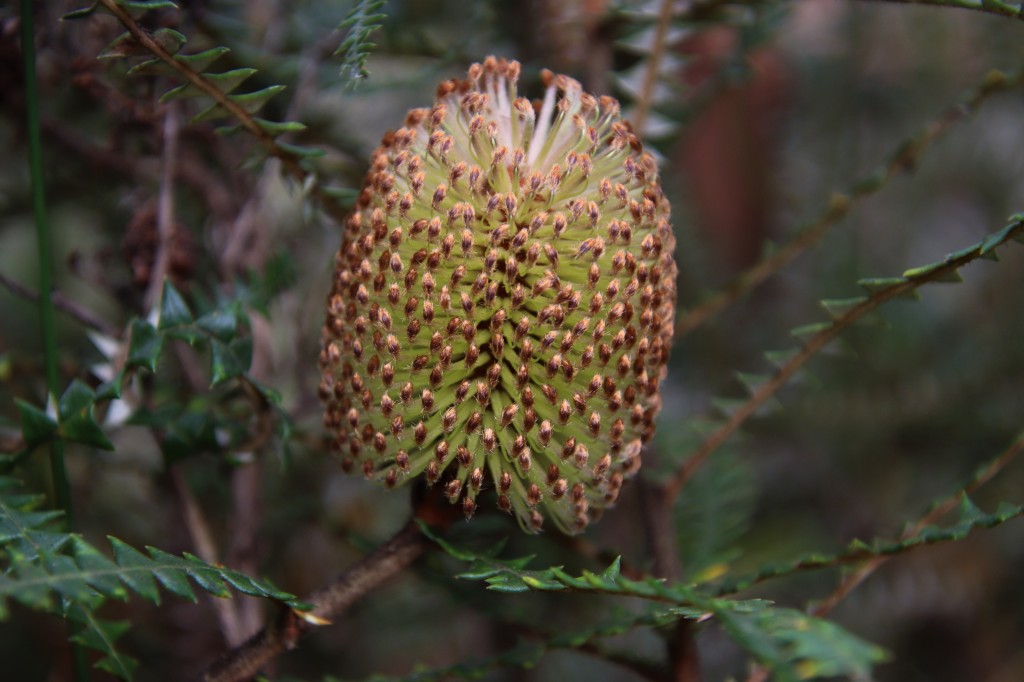
Munglinup to Esperance
In order to find a couple of far-flung Banksias on Western Australia’s South Coast the long drive was made to the vicinity of Esperance during the month of November. Both Banksia pilostylis and Banksia petiolaris can found flowering at this time. Pilostylis presents as a small tree while petiolaris is one of the six prostrate ground Banksias.
Exploring the roadside verges West of the small town of Munglinup, it quickly became apparent that there were only small numbers of pilostylis, with flowering cones well past their peak.
Exploration on foot of the vegetation lining Jerdacuttup Rd did eventually revealed petiolaris, but there was not a single flower in sight. November should be in the middle of the flowering period for both Banksias. The Spring had been very dry. Was it too late?
Bankia pilostylis
After driving further East into the agricultural hinterland North of Esperance, and taking the Coolgardie-Esperance Highway through the hamlet of Gibson, there were huge bushes of Banksia speciosa flowering extensively.
Remnant bush on Degrussa Road was where the first flashes of yellow led to Banksia pilostylis. Unlike West of Munglinup, these 2m bushes contained a profusion of flowers.
Dempster Rd was another location where Banksia pilostylis occurred, this time as understory in woodland. The species resembles Banksia media with whom it shares it’s distribution, sometimes growing alongside each other, but the flowering cones of pilostylis are identified by the smaller size.
Banksia pilostylis

Banksia petiolaris
Travelling on, the grid of gravel roads through the agricultural land resembled a maze, but it was an adventure to explore this area never before visited. There were small areas of residual bush but the majority of vegatation was found in thin roadside verges.
On Scaddan Road the ground became obviously sandy, and the large, erect, denate olive leaves of Banksia petiolaris became evident. This Banksia was a delightful monoculture over an area of 15 square metres. There were some flowers, although the majority had finished flowering. The residual flowers had survived because of shade afforded by adjacent trees.
The flowering cones of petiolaris are dwarfed by the giant leaves that were upto 40cm in height, and being so closed to the ground these in common with the other ground Banksias would certainly rely on small mammals for pollination. Further colonies were found on Eld Road and while the species was never common, it occurred extensively in suitable habitat.
Banksia petiolaris
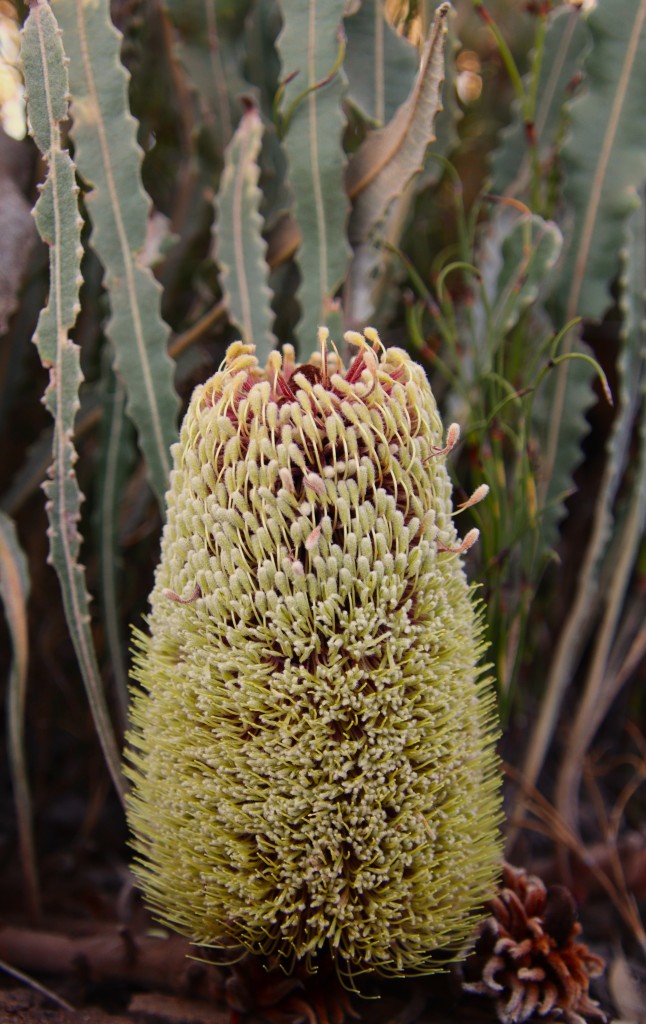
Now both species has been located I began the long return drive West. As mentioned the day was warm, and so a few reptiles were seen including the Western Bluetongue pictured below crossing one of the roads. These adorable skinks resemble bank robbers with the black eye stripe. Confdent with the lack of traffic I let the lizard slowly amble from the road.
Western Bluetongue

Darkness had well and truly fallen on arrival at Lake King. This was as far as I was prepared to drive that day. I managed to score the last room at the Lake King Tavern Motel, and as always there was a hearty meal at this charismatic outback pub.
The following morning I continued meandering Westward and stopped at Rock View Nature Reserve North of Newdegate for a poke around the bush. It was here another Banksia was unexpectedly found. The last of this South Coast blog
Banksia violacea – The Violet Banksia
Banksia violacea has a distribution from Woodanilling in the West through to Esperance in the East, although the area around Ravensthorpe and North of Fitzgerald River National Park is where it is most common.
The globular flowers, as the latin name suggests are purple tending black, and this dark colouration can make them quite concealed. They are similar in appearance to the Sphaerocarpa group in all of flower, leaf and plant shape, presenting as a small bush to 1.5m.
They flower from November through to February, so this plant was flowering at the very beginning of the season. The flower had a seductive black sheen in the bright, brilliant sunlight and is quite unlike the colouration of any other Banksia. An absolute highlight to finish the Blog on Banksias of the Wild South Coast.
Banksia violacea

Continued in what is my favorite of this 4 part series of Banksia blogs :-
Banksias of Perth and the Northern Sandplains
#QuollingAround
B for Banksia & B for Brilliant summary of this amazingly diverse and adapted to harshness plant! Just love this article in the epic series!! Pity there was not a little honey possum in those photos! But then they are nocturnal! Keep up the great work! Izzy & Daniel.✍🏼
LikeLike
Honey Possum was definitely an outside chance but would have been great!!!!
LikeLike